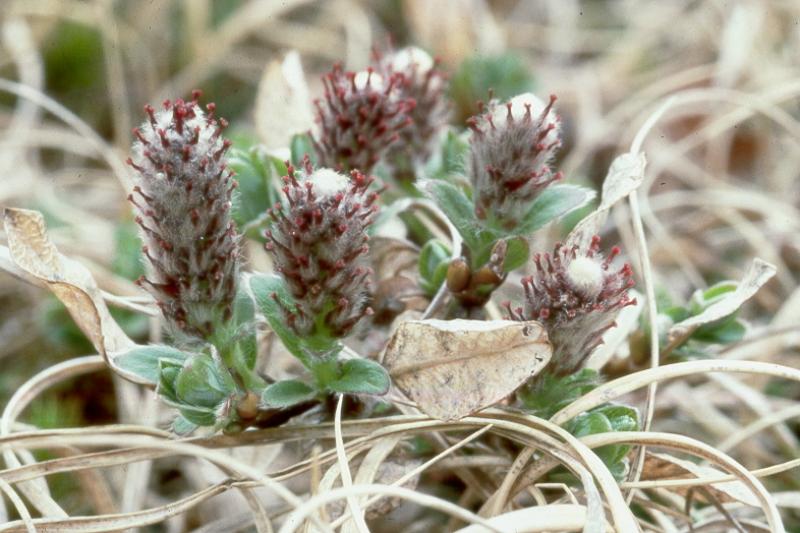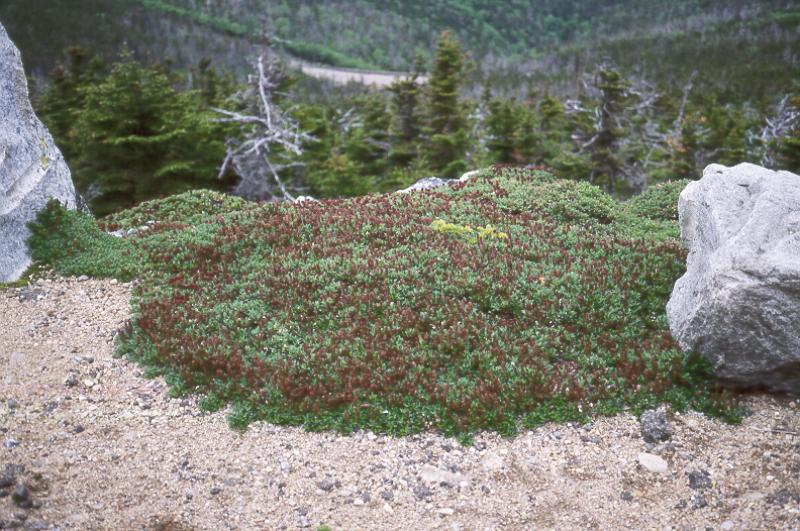Bearberry Willow
Salix uva-ursi Pursh
- Class
- Dicotyledoneae (Dicots)
- Family
- Salicaceae (Willow Family)
- State Protection
- Threatened
Listed as Threatened by New York State: likely to become Endangered in the foreseeable future. For animals, taking, importation, transportation, or possession is prohibited, except under license or permit. For plants, removal or damage without the consent of the landowner is prohibited.
- Federal Protection
- Not Listed
- State Conservation Status Rank
- S2
Imperiled in New York - Very vulnerable to disappearing from New York due to rarity or other factors; typically 6 to 20 populations or locations in New York, very few individuals, very restricted range, few remaining acres (or miles of stream), and/or steep declines.
- Global Conservation Status Rank
- G5
Secure globally - Common in the world; widespread and abundant (but may be rare in some parts of its range).
Summary
Did you know?
Frederick Pursh, who described this species, noted that its habit and leaves resemble those of the bearberry plant (Arctostaphylos uva-ursi). Therefore he used the species name uva-ursi, which means bearberry, for this species. Pursh also wrote that this is a "beautiful little species." Edward Tuckerman, a 19th-century botanist from Amherst College, did not think Pursh had adequately described the species, and renamed it Salix cutleri, after Reverend Manassah Cutler, an 18th-century botanist and congressman from Massachusetts. Pursh's original name was restored by willow expert M. S. Bebb (Bebb 1989).
State Ranking Justification
There are 11 known populations all of which are known from the high peaks in the Adirondacks. One population, which is close to another one and may be considered only a sub-population, is believed to be extirpated. Some populations are threatened by trampling from hiker traffic.
Short-term Trends
One population or sub-population appears to have become extirpated within the past 20 years. Overall, short-term trends are unclear but may indicate a slight decline.
Long-term Trends
Only one population or sub-population appears to have become extirpated within the past 20 years. About five of the eleven extant populations are known to have been extant for the past 100 years. Overall, long-term trends are unclear but probably indicate at least a slight decline.
Conservation and Management
Threats
At many sites trampling by hiker traffic threatens at least parts of the populations.
Conservation Strategies and Management Practices
The Summit Steward program which works to inform hikers of the fragile nature of alpine plants is a critical program which is helping to reduce trampling of alpine vegetation. This program and other efforts designed to reduce trampling of alpine meadows are needed.
Research Needs
Clear, consistent, and regular data on the size of populations is needed to better assess the trends of this species. Left unchecked, global climate change is an additional threat.
Habitat
Habitat
In New York, the species occurs exclusively in alpine areas on the highest summits of the mountains in the Adirondacks. It grows in open alpine meadows, sometimes adjacent to krummholz, and on or near rock ledges. It also occurs along trails in these habitats (New York Natural Heritage Program 2007). "Xerophytic lichen-heath tundra on wind-exposed places, rocky barrens on hills and ridges, solifluction slopes, polygonal tundra, frost boils, talus slopes at bases of snowpatches, marine terraces and bare gravel beaches, sand dunes, bare, dry exposed shallow soil; on fine sand, sandy-gravel, stony, and rocky materials derived from granite, gneiss, schist, hematite, serpentine, and dolomitic shale substrates" (Argus 2005). Exposed rocky places (Gleason and Cronquist 1991).
Associated Ecological Communities
- Open alpine community
(guide)
An open community consisting of a mosaic of sedge/dwarf shrub meadows, dwarf heath shrublands, small boggy depressions, and exposed bedrock covered with lichens and mosses. The open alpine community occurs above timberline (about 4,900 ft or 1,620 m) on the higher mountain summits and exposed ledges of the Adirondacks. The flora includes arctic-alpine species that are restricted (in New York) to these areas, as well as boreal species that occur in forests and bogs at lower elevations. The soils are thin and organic, primarily composed of peat derived from peat mosses (Sphagnum spp.) or black muck. The soils are often saturated because they can be recharged by atmospheric moisture.
Associated Species
- Agrostis mertensii (northern bent)
- Betula glandulosa (alpine birch, resin birch)
- Carex bigelowii
- Diapensia lapponica var. lapponica
- Empetrum eamesii ssp. atropurpureum
- Empetrum nigrum ssp. hermaphroditum
- Huperzia appressa (mountain firmoss)
- Juncus trifidus
- Minuartia groenlandica
- Prenanthes boottii
- Prenanthes nana
- Rhododendron lapponicum var. lapponicum
- Solidago leiocarpa (Cutler's alpine goldenrod)
- Trichophorum caespitosum
- Vaccinium boreale (northern lowbush blueberry)
- Vaccinium uliginosum (bog bilberry)
Range
New York State Distribution
In New York, this species is only known from the high peaks region of the Adirondacks in Essex County.
Global Distribution
This species is an arctic-alpine North American endemic. It occurs from Nunavut east to Greenland and south to Quebec and the mountains of northern New England and New York (Argus 2005).
Identification Comments
General Description
Bearberry willow is a low shrub that forms dense mats 1-5 cm tall and 20-90 cm across. The stout branches are prostrate and trail along the ground. The elliptic leaves are up to 3/4 inches long and have teeth along the margins that are green, shiney and rarely slightly hairy above and whitish below. Like all willows, the flowers are small and occur in tight clusters called catkins. Catkins are composed entirely of either male or female flowers and individual plants have either all male or all female catkins. This species flowers as the leaves are opening. Female catkins are about 1/2 to 2 inches long and stand erect among the leaves. The white to red female flowers develop into capsules which are less than 1/4 inches long, and not hairy (Fernald 1970, Argus 2005).
Identifying Characteristics
Salix uva-ursi is a matted dwarf shrub that forms colonies by layering and is only 1-5 cm tall. The branches and stems often are horizontal and prostrate. The leaves are broadly ovate to oblanceolate or elliptic, glandular-serrulate to glandular-crenate, the apices are acute to acuminate, and the blades are 4-23 mm long. The adaxial leaf surfaces are green and shining while the abaxial surfaces are glaucous and usually glabrous. There is one stamen per staminate flower.
Best Life Stage for Proper Identification
This species can easily be identified vegetatively when the leaves are fully expanded. Information on habitat and habit are particularly useful and should be noted along with the color of the abaxial surface.
Similar Species
Salix uva-ursi is a very distinctive willow that in New York only occurs in alpine regions.
Salix herbacea is the other dwarf willow that occurs in alpine areas in New York. It can be distinguished by its leaves which are green abaxially and have a rounded to notched apex, and by its styles being 0.2-0.4 mm long.
Salix pyrifolia is a taller willow but often occurs in high elevation sites. It can be distinguished by its height (0.4-4.0 m tall) and non-prostrate growth habit, and by its two stamens per staminate flower.
Best Time to See
This species has mature foliage by mid-June and the leaves last through September. Therefore, the best time to survey for this species is during this time period.
- Vegetative
- Flowering
- Fruiting
The time of year you would expect to find Bearberry Willow vegetative, flowering, and fruiting in New York.
Bearberry Willow Images
Taxonomy
Bearberry Willow
Salix uva-ursi Pursh
- Kingdom Plantae
- Phylum Anthophyta
- Class Dicotyledoneae
(Dicots)
- Order Salicales
- Family Salicaceae (Willow Family)
- Order Salicales
- Class Dicotyledoneae
(Dicots)
- Phylum Anthophyta
Synonyms
- Salix cutleri Tuckerman.
Comments on the Classification
The hybrid Salix x peasei (Salix herbacea x S. uva-ursi) is known from New Hampshire and areas to the north, but has never been reported from New York (Fernald 1970, Argus 2005).
Additional Resources
Best Identification Reference
Haines, A. and T.F. Vining. 1998. Flora of Maine, A Manual for Identification of Native and Naturalized Vascular Plants of Maine. V.F.Thomas Co., Bar Harbor, Maine.
Other References
Argus, G.W. 2005. Guide to the Identification of the Genus Salix (Willow) in New England and New York. Unpublished manuscript.
Bebb, M.S. 1889. White Mountain Willows - III. Bulletin of The Torrey Botanical Club, Vol. 16 (8). pp. 211-215.
Fernald, M.L. 1950. Gray's manual of botany. 8th edition. D. Van Nostrand, New York. 1632 pp.
Gleason, Henry A. and A. Cronquist. 1991. Manual of Vascular Plants of Northeastern United States and Adjacent Canada. The New York Botanical Garden, Bronx, New York. 910 pp.
Holmgren, Noel. 1998. The Illustrated Companion to Gleason and Cronquist's Manual. Illustrations of the Vascular Plants of Northeastern United States and Adjacent Canada. The New York Botanical Garden, Bronx, New York.
Mitchell, Richard S. and Gordon C. Tucker. 1997. Revised Checklist of New York State Plants. Contributions to a Flora of New York State. Checklist IV. Bulletin No. 490. New York State Museum. Albany, NY. 400 pp.
New York Natural Heritage Program. 2010. Biotics database. New York Natural Heritage Program. New York State Department of Environmental Conservation. Albany, NY.
New York Natural Heritage Program. 2024. New York Natural Heritage Program Databases. Albany, NY.
Reschke, Carol. 1990. Ecological communities of New York State. New York Natural Heritage Program, New York State Department of Environmental Conservation. Latham, NY. 96 pp. plus xi.
Weldy, T. and D. Werier. 2010. New York flora atlas. [S.M. Landry, K.N. Campbell, and L.D. Mabe (original application development), Florida Center for Community Design and Research http://www.fccdr.usf.edu/. University of South Florida http://www.usf.edu/]. New York Flora Association http://newyork.plantatlas.usf.edu/, Albany, New York
Links
About This Guide
Information for this guide was last updated on: December 29, 2008
Please cite this page as:
New York Natural Heritage Program. 2024.
Online Conservation Guide for
Salix uva-ursi.
Available from: https://guides.nynhp.org/bearberry-willow/.
Accessed July 26, 2024.

